The Crested Goshawk (Accipiter trivirgatus) emerges as a captivating avian species, embodying a combination of elegance and predatory prowess.
As a bird of prey belonging to the Accipitridae family, this raptor showcases distinct features that set it apart in the avian realm.
The notable crest on its head, coupled with a sleek build and keen hunting instincts, defines the Crested Goshawk’s unique identity.
Found in various habitats across Asia, from tropical forests to urban areas, this adaptable species thrives in diverse ecosystems. Its striking appearance and agile flight make it a subject of fascination for bird enthusiasts and researchers alike.
Delving into the world of the Crested Goshawk unveils a story of adaptability, survival strategies, and the crucial role it plays in maintaining ecological balance within its habitat.
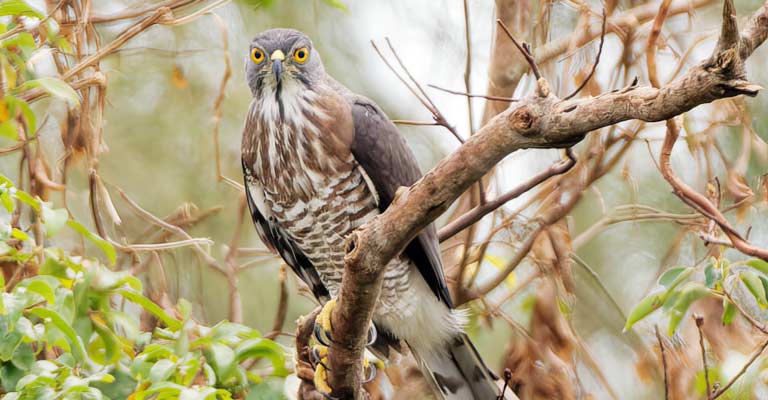
Taxonomy of Crested Goshawk
Below is a table outlining the taxonomical details of the Crested Goshawk (Accipiter trivirgatus):
| Taxonomic Level | Classification |
| Domain | Eukaryota |
| Kingdom | Animalia |
| Phylum | Chordata |
| Class | Aves |
| Order | Accipitriformes |
| Family | Accipitridae |
| Genus | Accipiter |
| Species | A. trivirgatus |
Crested Goshawk (Accipiter trivirgatus) certainly has some subspecies. They are as follows:
A. t. indicus (Hodgson, 1836)
Found in the Indian subcontinent, A. t. indicus exhibits adaptations to its specific habitat. It shares the general characteristics of the Crested Goshawk, including the prominent crest, but regional environmental factors may influence slight variations in plumage color and size.
A. t. formosae – Mayr, 1949
Inhabiting Taiwan, A. t. formosae showcases features adapted to the island’s unique ecological conditions. As with many island populations, there may be distinctiveness in terms of size and coloration influenced by local environments.
A. t. peninsulae – Koelz, 1949
Native to the Malay Peninsula, A. t. peninsulae is well-suited to the diverse habitats of the region. The adaptation to the peninsula’s varied ecosystems may result in subtle differences in physical traits compared to other subspecies.
A. t. layardi (Whistler, 1936)
Endemic to Sri Lanka, A. t. layardi embodies characteristics finely tuned to the island’s ecosystems. The subtle variations in plumage and size may reflect adaptations to the specific environmental conditions of Sri Lanka.
A. t. trivirgatus (Temminck, 1824)
The nominate subspecies, A. t. trivirgatus, is distributed across Southeast Asia.
This widespread subspecies encompasses diverse habitats, from tropical rainforests to open woodlands, showcasing adaptability in response to a range of ecological niches.
A. t. niasensis – Mayr, 1949
Endemic to Nias Island in Indonesia, this subspecies likely displays adaptations to the unique ecological conditions of the island.
Variations in size and plumage may reflect the specific challenges and opportunities presented by Nias Island’s environment.
A. t. javanicus – Mayr, 1949
Inhabiting Java, Indonesia, A. t. javanicus demonstrates characteristics shaped by the island’s diverse habitats.
The adaptation to Java’s ecosystems may result in distinct plumage patterns and possibly variations in size compared to other subspecies.
A. t. microstictus – Mayr, 1949
Distributed across the Sunda Islands, A. t. microstictus encompasses a range of environments. This subspecies likely exhibits adaptations to the varied ecosystems of the Sunda Islands, influencing its physical traits.
A. t. palawanus – Mayr, 1949
Native to Palawan Island in the Philippines, A. t. palawanus showcases characteristics tailored to the island’s specific ecological niches. The insular nature of Palawan may contribute to unique features within this subspecies.
A. t. castroi – Manuel & Gilliard, 1952
Found in the Talaud and Sangihe Islands in Indonesia, A. t. castroi adapts to the challenges of these specific island environments. Island populations often exhibit distinctive traits, influenced by isolation and local ecological factors.
A. t. extimus – Mayr, 1945
This subspecies, distributed in the northern part of the Philippines, may face unique ecological pressures. A. t. extimus likely demonstrates adaptations to the diverse habitats found in the Philippines’ northern regions.
While the Crested Goshawk’s overall appearance and behavior are consistent across its range, the variations among these subspecies highlight the dynamic interplay between genetics and environmental factors.
Studying these subspecies provides valuable insights into the adaptive evolution of the Crested Goshawk across different regions, contributing to a comprehensive understanding of the species as a whole.
Physical Characteristics of Crested Goshawk
The Crested Goshawk (Accipiter trivirgatus) is a striking bird of prey with distinctive physical characteristics that aid in its identification. Here are eight key points to consider when identifying the Crested Goshawk:
Size and Build
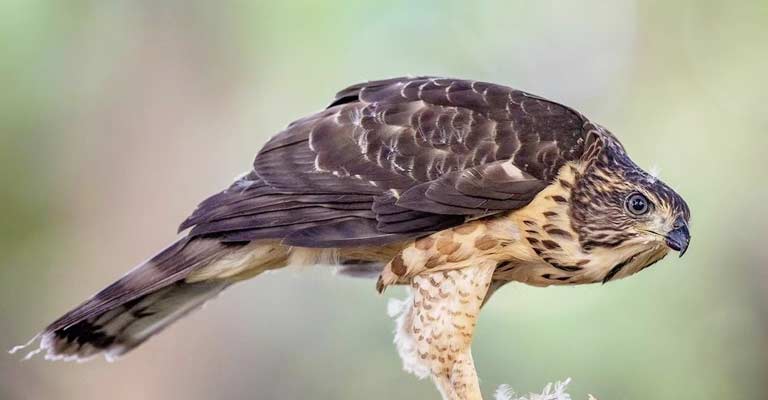
The Crested Goshawk is a medium-sized raptor, typically measuring between 30 to 46 centimeters in length. It possesses a robust and compact build, exhibiting strength and agility in flight.
Crest on Head
One of the most conspicuous features is the crest on its head. The crest is a prominent set of feathers that can be erected, especially during displays or moments of heightened alertness.
The crest adds to the bird’s overall regal appearance.
Plumage Coloration
Adult Crested Goshawks showcase a distinctive coloration with dark upperparts, including a dark hood, contrasting with lighter underparts that may have fine barring. Juveniles often have a more mottled or streaked appearance.
Eye Color
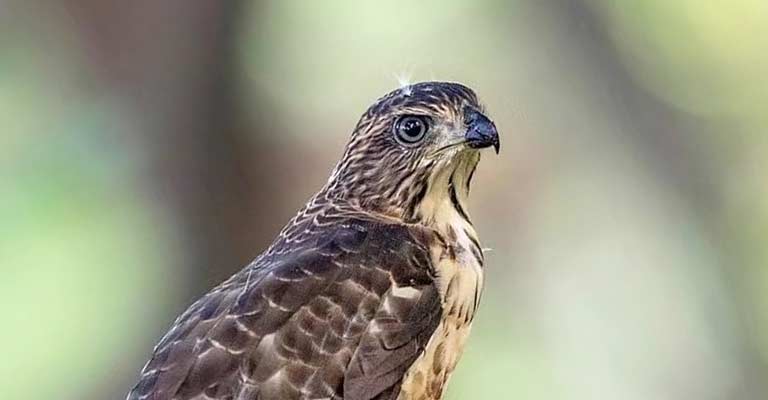
The eyes of the Crested Goshawk are a vivid red or orange, creating a striking contrast with its plumage. The intensity of the eye color contributes to its focused and predatory gaze.
Tail Bands
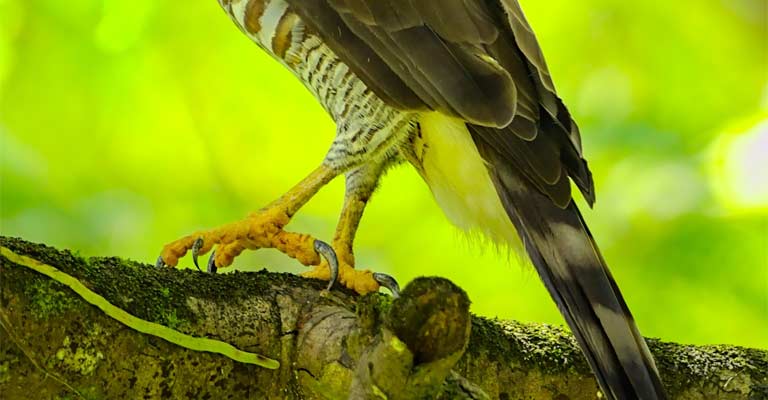
The tail of the Crested Goshawk features bold black bands, often with three distinct bands. These bands are a key identification feature and can be observed during flight or when the bird is perched.
Wing Shape
The wings are short and rounded, allowing for maneuverability during flight. The shape of the wings is particularly adapted for navigating through the dense vegetation of its habitat.
Facial Features
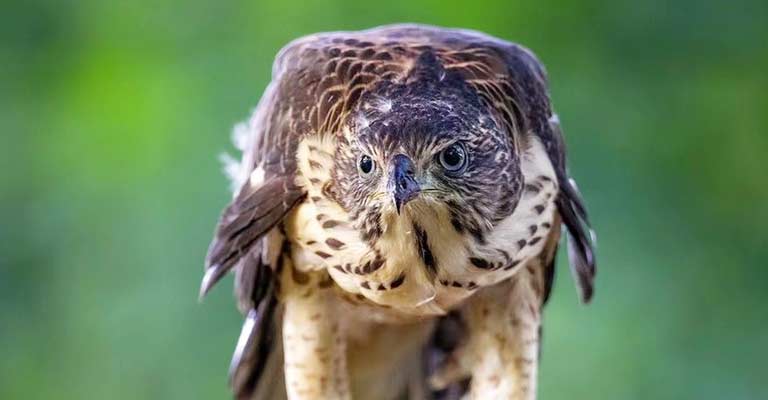
Crested Goshawks have a distinctive facial mask, characterized by dark markings around the eyes and a hooked beak. This facial pattern contributes to their predatory appearance and aids in focusing on prey.
The Crested Goshawk’s identification relies on a combination of size, the presence of a crest, plumage coloration, eye color, tail bands, wing shape, facial features, and understanding its habitat preferences.
As an elegant and formidable predator, the Crested Goshawk’s physical characteristics contribute to its uniqueness within the avian world.
Crested Goshawk Life History
The life history of the Crested Goshawk (Accipiter trivirgatus) unveils a captivating narrative of a raptor that gracefully navigates the intricate balance of predation, reproduction, and ecological adaptability.
This medium-sized bird of prey, characterized by a distinct crest on its head, has carved its place in the diverse landscapes of Asia.
From its dietary habits to nesting strategies and conservation challenges, the Crested Goshawk’s life history reflects a dynamic interplay between biology and environment.
Food
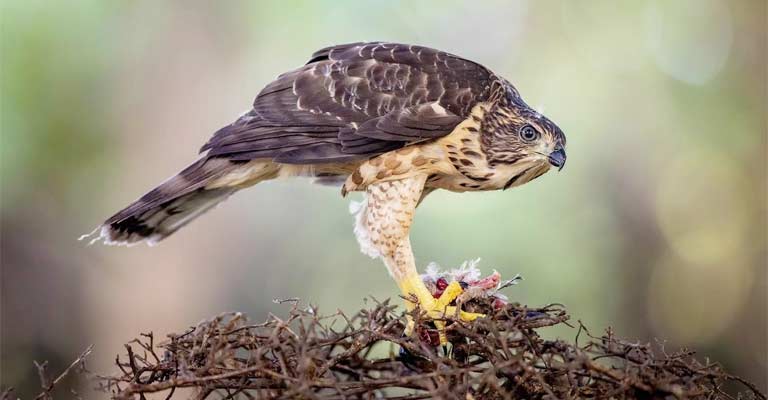
Crested Goshawks are formidable predators with a diverse diet. Their primary prey includes small birds, mammals, and occasionally insects.
Agile in flight and possessing sharp talons, they execute swift and precise strikes to capture their prey, showcasing adaptability to various hunting techniques depending on the availability of resources.
Habitat
This adaptable raptor thrives in a wide range of habitats, from dense tropical rainforests to mixed woodlands and even urban areas.
The Crested Goshawk’s ability to navigate diverse ecosystems emphasizes its flexibility and resilience in the face of changing landscapes.
Range Map
The Crested Goshawk’s range spans across Southeast Asia, covering countries such as India, Indonesia, Malaysia, and the Philippines.
A detailed range map illustrates the distribution of different subspecies, each adapted to the specific environmental conditions of its geographical location.
Nesting
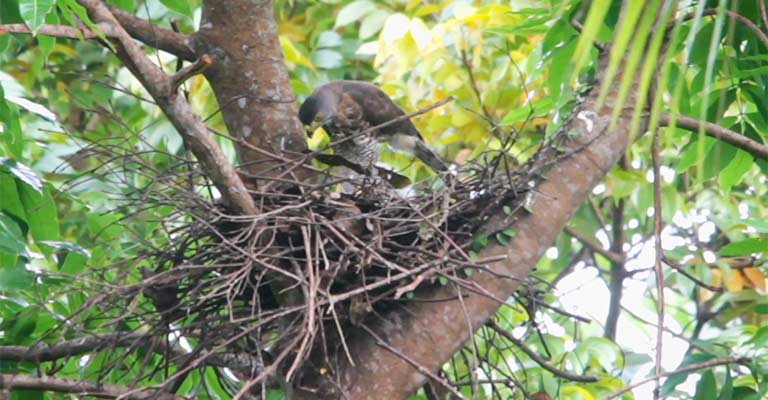
Nesting behavior involves the construction of sturdy platforms made from sticks, typically situated high in the canopy of trees.
The Crested Goshawk strategically selects concealed locations to protect its nest from potential predators, showcasing an evolutionary response to ensure the safety of its offspring.
Certainly! Here’s a table summarizing the nesting details of the Crested Goshawk (Accipiter trivirgatus):
| Nesting Details | Facts |
| Clutch Size | Typically 2 to 3 eggs |
| Number of Broods | Usually 1 to 2 broods per breeding season |
| Egg Length | Approximately 4.5 to 5.5 centimeters |
| Egg Width | Around 3.5 to 4.0 centimeters |
| Incubation Period | Approximately 30 to 35 days |
| Nestling Period | About 4 to 5 weeks |
| Egg Description | Oval-shaped, with a pale background and irregular reddish-brown markings. |
| Nest Type | Constructed with sticks, placed in the canopy of tall trees, often concealed for protection. |
| Parental Involvement | Both male and female participate in incubation and feeding of the nestlings. |
Breeding
Crested Goshawks engage in monogamous breeding pairs. Courtship displays involve aerial acrobatics and vocalizations, reinforcing pair bonds.
The female lays a clutch of eggs, and both parents actively participate in incubation and raising the nestlings, highlighting cooperative parenting strategies.
Diseases
While resilient, Crested Goshawks can be susceptible to various diseases that may impact their overall health and reproductive success. Monitoring for signs of illness is crucial for early intervention and conservation efforts.
Treatment
Addressing diseases requires a comprehensive approach, including veterinary care, habitat preservation, and mitigating potential threats.
Collaboration between wildlife experts, researchers, and conservationists is instrumental in ensuring the well-being of the Crested Goshawk population.
Conservation
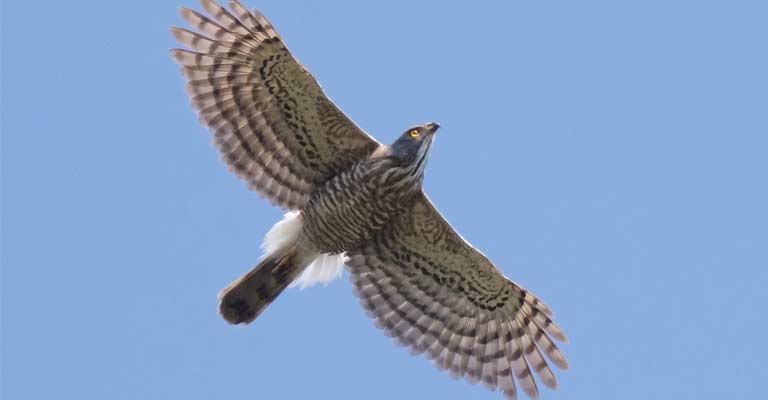
Conservation efforts for the Crested Goshawk are paramount, considering habitat loss and potential threats.
Implementing measures such as habitat preservation, monitoring breeding success, and raising awareness about their ecological role contribute to safeguarding this adaptable and integral species within the avian landscape.
As urbanization continues to encroach upon natural habitats, proactive conservation measures become increasingly vital for the sustained existence of the Crested Goshawk.
10 Surprising Facts About Crested Goshawk
The Crested Goshawk (Accipiter trivirgatus) is a captivating raptor with an array of surprising facts that add to its mystique within the avian realm. Here are 10 intriguing insights into the life and characteristics of the Crested Goshawk:
- Distinctive Crest: True to its name, the Crested Goshawk boasts a conspicuous crest atop its head. This distinctive feature, often raised during moments of alertness, contributes to its regal appearance.
- Urban Prowess: Unlike many raptors, Crested Goshawks display adaptability to urban environments. They are often spotted in parks and gardens, showcasing their ability to coexist with human activities.
- Agile Hunters: Equipped with sharp talons and keen vision, Crested Goshawks are agile hunters. Their hunting techniques include swift and precise strikes, making them effective predators of small birds and mammals.
- Variety of Habitats: From tropical rainforests to mixed woodlands, Crested Goshawks thrive in diverse habitats across Southeast Asia. This adaptability underscores their ability to navigate varied ecosystems.
- Island Endemism: Several subspecies, such as A. t. niasensis and A. t. javanicus, are island endemics. These populations exhibit unique adaptations shaped by the ecological dynamics of their specific islands.
- Monogamous Bonds: Crested Goshawks engage in monogamous breeding pairs, forming strong bonds. Courtship displays involve aerial acrobatics and vocalizations, emphasizing the importance of pair cooperation.
- Nesting Concealment: Nest construction involves sturdy platforms of sticks, strategically placed high in the canopy of trees for concealment. This adaptation minimizes the risk of predation on eggs and nestlings.
- Vocal Displays: Crested Goshawks communicate through a variety of vocalizations, including sharp calls. These vocal displays play a role in establishing territories and maintaining communication within pairs.
- Conservation Challenges: Despite their adaptability, Crested Goshawks face conservation challenges such as habitat loss and potential threats. This underscores the importance of proactive conservation measures.
- Energetic Flight: Characterized by direct and powerful flight, Crested Goshawks navigate their habitats with agility. Their flight patterns are a testament to their prowess in both pursuing prey and defending territories.
The Crested Goshawk weaves a narrative of adaptability, urban presence, and predatory excellence.
Understanding these surprising facets not only deepens our appreciation for this remarkable raptor but also emphasizes the need for conservation efforts to ensure its continued existence in the ever-changing landscapes of Southeast Asia.
Wrapping Up
The Crested Goshawk stands as a symbol of avian resilience, adapting to diverse habitats and captivating observers with its distinctive features.
From its urban forays to intricate nesting behaviors, this raptor navigates the dynamic interplay between nature and human-altered landscapes.
As we uncover the surprising facets of its life, from monogamous pair bonds to island endemism, the Crested Goshawk invites us into the fascinating world of avian adaptation.
Yet, with conservation challenges looming, our understanding and appreciation are integral to ensuring the continued survival of this majestic bird, reinforcing the importance of preserving its habitats and addressing potential threats.